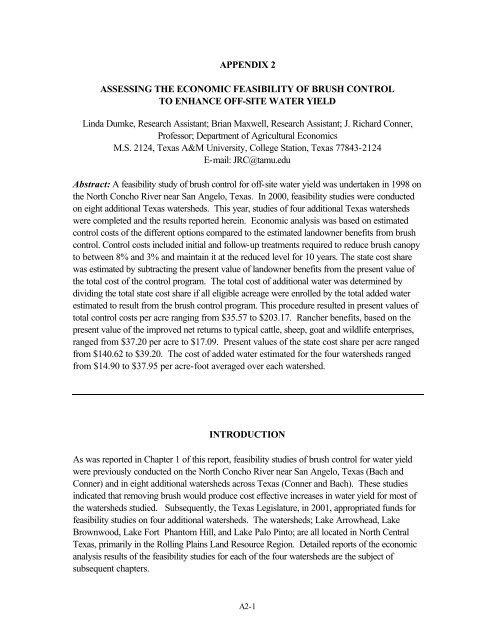Lake Brownwood Watershed - Texas State Soil and Water ...
Lake Brownwood Watershed - Texas State Soil and Water ...
Lake Brownwood Watershed - Texas State Soil and Water ...
You also want an ePaper? Increase the reach of your titles
YUMPU automatically turns print PDFs into web optimized ePapers that Google loves.
APPENDIX 2<br />
ASSESSING THE ECONOMIC FEASIBILITY OF BRUSH CONTROL<br />
TO ENHANCE OFF-SITE WATER YIELD<br />
Linda Dumke, Research Assistant; Brian Maxwell, Research Assistant; J. Richard Conner,<br />
Professor; Department of Agricultural Economics<br />
M.S. 2124, <strong>Texas</strong> A&M University, College Station, <strong>Texas</strong> 77843-2124<br />
E-mail: JRC@tamu.edu<br />
Abstract: A feasibility study of brush control for off-site water yield was undertaken in 1998 on<br />
the North Concho River near San Angelo, <strong>Texas</strong>. In 2000, feasibility studies were conducted<br />
on eight additional <strong>Texas</strong> watersheds. This year, studies of four additional <strong>Texas</strong> watersheds<br />
were completed <strong>and</strong> the results reported herein. Economic analysis was based on estimated<br />
control costs of the different options compared to the estimated l<strong>and</strong>owner benefits from brush<br />
control. Control costs included initial <strong>and</strong> follow-up treatments required to reduce brush canopy<br />
to between 8% <strong>and</strong> 3% <strong>and</strong> maintain it at the reduced level for 10 years. The state cost share<br />
was estimated by subtracting the present value of l<strong>and</strong>owner benefits from the present value of<br />
the total cost of the control program. The total cost of additional water was determined by<br />
dividing the total state cost share if all eligible acreage were enrolled by the total added water<br />
estimated to result from the brush control program. This procedure resulted in present values of<br />
total control costs per acre ranging from $35.57 to $203.17. Rancher benefits, based on the<br />
present value of the improved net returns to typical cattle, sheep, goat <strong>and</strong> wildlife enterprises,<br />
ranged from $37.20 per acre to $17.09. Present values of the state cost share per acre ranged<br />
from $140.62 to $39.20. The cost of added water estimated for the four watersheds ranged<br />
from $14.90 to $37.95 per acre-foot averaged over each watershed.<br />
INTRODUCTION<br />
As was reported in Chapter 1 of this report, feasibility studies of brush control for water yield<br />
were previously conducted on the North Concho River near San Angelo, <strong>Texas</strong> (Bach <strong>and</strong><br />
Conner) <strong>and</strong> in eight additional watersheds across <strong>Texas</strong> (Conner <strong>and</strong> Bach). These studies<br />
indicated that removing brush would produce cost effective increases in water yield for most of<br />
the watersheds studied. Subsequently, the <strong>Texas</strong> Legislature, in 2001, appropriated funds for<br />
feasibility studies on four additional watersheds. The watersheds; <strong>Lake</strong> Arrowhead, <strong>Lake</strong><br />
<strong>Brownwood</strong>, <strong>Lake</strong> Fort Phantom Hill, <strong>and</strong> <strong>Lake</strong> Palo Pinto; are all located in North Central<br />
<strong>Texas</strong>, primarily in the Rolling Plains L<strong>and</strong> Resource Region. Detailed reports of the economic<br />
analysis results of the feasibility studies for each of the four watersheds are the subject of<br />
subsequent chapters.<br />
A2-1



